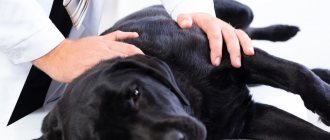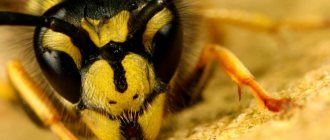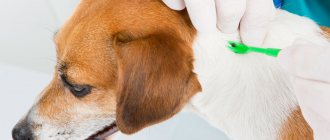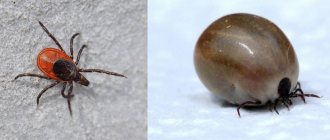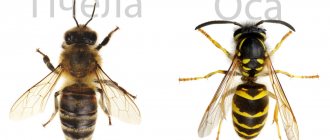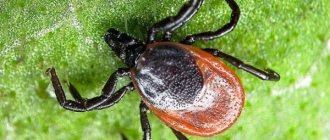Stinging insects pose a danger not only to people, but also to their four-legged pets. If a dog is stung by a bee, it may also develop an allergy. If angioedema or suffocation occurs, the injured pet must be given first aid and urgently taken to a veterinarian. Otherwise, he risks dying from the injected poison.
Bee sting: is it dangerous?
When bees bite, they dig into the skin of a domestic animal and leave a sting in it, which contains barbs and a poisonous sac.
If the dog encounters not a bee, but a hornet, bumblebee or wasp, they may also bite. Dog and bee
Note! Bees don't bite, they sting. They can do this only once, after which they die, leaving a sting in the enemy’s body with part of their intestines.
After a bee sting, the animal's paws and nose usually swell. But in addition, other troubles may develop:
- Anaphylactic shock is a consequence of an allergic reaction to an insect bite. Main symptoms: blisters form on the skin, severe swelling of the tissues and skin, wheezing is heard during breathing, possible vomiting, convulsions, involuntary bowel movements and gall bladder, and a plaintive whining.
- Suffocation. It’s not so scary if the dog is stung by an insect, for example, on the paw. It is much worse if a honey insect flew into the mouth of a curious pet. In most cases, the dog's oxygen supply is blocked, so assistance must be provided immediately.
- An allergic reaction develops mainly only if the dog is bitten by several bees at the same time or with a slight difference in time. Against this background, the following symptoms may develop: severe itching and swelling at the site of the bite, upset of the digestive tract, and fever.
Slight swelling and a single squeal are a normal reaction and there is no cause for concern. If more severe symptoms develop, you must take your dog to the hospital immediately, otherwise it can lead to death.
When to urgently contact a veterinarian
The pet owner should not self-medicate in the following situations:
- If your pet is bitten by several bees or wasps at once;
- If the animal's face is injured or the dog swallows a stinging insect;
- The dog’s health deteriorated and signs of a serious allergy appeared;
- The pet was not healthy even before the bite.
Remember that a harmless bite can cause many unpleasant moments for your dog.
Therefore, try to monitor him more closely after an unpleasant situation and if his condition worsens, do not be afraid to contact a veterinarian. On our website there are more than 3390 veterinary clinics in Moscow for you on our website injections for animals
Symptoms of a Dog Insect Bite
A cat was bitten by a wasp or a bee: what to do at home
If your dog is bitten by a bee, you need to carefully monitor your pet's condition for a while. If alarming symptoms appear, your pet should be taken to a veterinarian as soon as possible.
Dachshund bitten by bees
A dog bee sting may be accompanied by the development of the following clinical picture:
- the dog whines and jumps away from the bite site or, on the contrary, tries to attack;
- after a short period of time, pain and swelling develop at the site of the bite, the muzzle becomes swollen;
- if the bite site is in the mouth, then the palate and mouth swell primarily, the dog cannot close it, and there is abundant salivation.
Subsequently, symptoms develop individually. A puppy and an adult dog may experience rapid heartbeat and fever, feverish trembling, vomiting and diarrhea, unsteadiness of gait, disorientation in space.
Precautionary measures
To protect your pets from bee stings, you should adhere to the following precautions:
- Do not walk near the apiary.
- If you take your pets out of town, take a home first aid kit for your dog with you. It should contain antihistamines.
- Do not allow your dog to walk in flower beds or near flowering bushes, which attract wasps and bees with their color.
- If a bee or wasp has flown into the house, you need to open the window and shoo away the insect with a towel. Animals should be isolated in another room.
- When going outdoors, you should take into account that the smells of perfumes and sweets attract these insects.
- If a pet is taken to the country, you should make sure that there are no nests of wasps or bees on the site. Otherwise, take measures to destroy them.
- If a sting occurs and it is necessary to carry out a painful procedure for removing the sting or an injection, you need to behave confidently and firmly so that the dog feels that you are the leader. Procedures should be carried out quickly. If necessary, use another person to restrain the dog or tie it up.
In most cases, when a dog is stung by a bee, it is enough to treat the sting site, but sometimes an injection is not necessary. During the summer, it is recommended to keep antiallergic drugs in your home medicine cabinet, which can save the animal’s life.
Signs of a bee sting in dogs
- swelling at the bite site
- facial swelling
- redness
- pain at the bite site
- itching at the bite site
- difficulty breathing
- weakness
- vomit
- diarrhea
- convulsions
- nervousness
- dizziness
- salivation
While some bee stings are minor, others can cause life-threatening symptoms in your dog. Symptoms of a bee sting are similar to those in humans and usually include only swelling, redness, pain and mild itching around the sting site . Sometimes there may be hives on the body. These symptoms are usually not very severe and are of short duration. However, other symptoms can be very worrying. Some dogs may experience difficulty breathing, vomiting and diarrhea, nervousness, watery eyes, weakness, dizziness and even seizures. These symptoms usually appear within about 20 minutes, but may not appear for several hours after a bee sting.
The first symptom of a bee sting is usually barking or howling from the dog after the sting. If a bee stings your dog on the leg, he may limp, hold his paw, or lick it. If the sting is on your dog's face or mouth, he may lick his lips and rub his face on the ground. Redness and swelling at the site of the bite occurs quite quickly before other symptoms.
What not to do
- independently try to bring the dog out of anaphylactic shock, especially if it is accompanied by swelling of the upper respiratory tract;
- treat the bite site with alcohol-containing substances;
- give human antihistamines without consulting a veterinarian (at least by phone), because not all medications are suitable for dogs;
- do not use any essential oils, especially if the bite is on the head - an additional strong smell can increase swelling.
Treatment for bee stings in dogs
If your dog is stung by a bee, you don’t need to panic right away, you should first monitor the dog’s breathing. If your dog has trouble breathing at any time or shows signs other than minor redness, itching, pain and swelling at the bite site, your veterinarian should see it as soon as possible. Sometimes home care is not enough and quick-acting injections of steroids and antihistamines along with oxygen therapy are required.
Here is a list of things you should do if your dog is stung by a bee.:
- Remove the stinger - First remove the dog's stinger, if you can find it. Do not use tweezers to remove the sting as this may force out more venom.
- Disinfect the bite site - After removing the sting, you can apply a mixture of baking soda and water to create a soothing paste on the bite site.
- Reduce Swelling – To reduce swelling, you can hold an ice pack on the bite site for 10 minutes.
- Protect the bite site from your dog's influence - If your dog is scratching the bite site and injuring himself, it may be worth trying to put a sock on your dog's foot to reduce the risk of further injury.
- Call your veterinarian – Finally, call your veterinarian to make sure it is safe to give your dog an antihistamine, such as diphenhydramine . This medication will reduce bee sting symptoms and help your dog feel more comfortable.
Remember to use common sense and remain calm, as nerves will only hurt you. Dogs take on our emotions.
Main signs of anaphylaxis
- severe inhibition in behavior, the dog seems to go limp, becomes lethargic and practically does not react to what is happening around;
- mucous membranes become almost white, sometimes with a bluish tint (attention is drawn to the inner surface of the cheeks, conjunctiva and whites of the eyes, gums);
- breathing becomes difficult, wheezing appears (these signs develop very quickly if the dog is bitten in the face by a wasp);
- vomiting may occur;
- convulsions;
- the pulse becomes barely perceptible in filling, but at the same time rapid;
- involuntary emptying of the bladder;
- Body temperature may rise.
With such symptoms, the dog should be taken to the clinic immediately!
First aid
In the event of a bite, behave calmly, do not panic or scold the dog under any circumstances: after all, the dog is already stressed from pain and surprise. Take the following actions as soon as possible:
- Pull out the sting if there is one.
Insects sting in different ways: for example, a sting remains at the site of a bee sting; wasps, bumblebees and hornets do not leave it. Therefore, if a dog is bitten by a bee, the sting must be removed immediately. This can be done using tweezers, nails, nail scissors, or a handy tool such as a plastic card. There is a sac with poison on the bee sting, so it must be pulled out carefully, using sliding movements, so that the remaining toxic substance is not squeezed out and does not enter the animal’s blood. - Treat the stung area.
Apply a gauze or cotton swab soaked with water and ammonia to the dog's paw, nose or lip. The bite can also be washed with alcohol or even regular vodka. If you don’t have anything like this on hand, just rinse with water. - Apply a cold compress.
Cold helps reduce swelling, reduce pain and slow down the absorption of bee venom. Do not keep the ice pack on for more than 15 minutes. During all these manipulations, talk to the dog and calm it with your voice. - Use folk remedies.
the cous can be treated with grated parsley leaves, dandelion juice, plantain or honey. - In case of numerous bites, provide the dog with plenty of fluids
- this will help the toxic substances leave the dog’s body faster. - Lubricate the wound with an anti-allergic ointment that relieves itching
. This is important because, as any dog lover knows, a dog can easily scratch an itchy bee sting and cause an infection. As such a remedy, you can use fenistil, lorinden, one percent hydrocortisone ointment, etc. - Give your dog an antihistamine.
One tablet of suprastin, loratadine, diphenhydramine or tavegil will be enough.
As a rule, these measures are sufficient for a bite on the paw. During the first time after a bite, observe the dog as carefully as possible in order to promptly notice the manifestation of an acute allergy to the bite of a poisonous insect.
Causes of animal bites
Every person should know why and how often wasps bite surrounding animals and people. Having familiarized yourself with the reasons in detail, you will be able to protect yourself and your beloved pet.
It is worth remembering that one of the main rules of wasp groups is self-defense, therefore, a wasp will never bite without any reason. A secondary factor is considered to be the manifestation of aggression towards wasps, so you should not hastily wave your arms and drive the insect away from you, as it may regard such behavior as an act of attack.
With animals everything is much more complicated. The owner will not be able to explain to his pet that it is forbidden to attack a wasp as a result of close contact. In this case, it is better to use special means that will prevent the insect from getting closer to the animal. However, situations are different, and special equipment does not always provide the necessary protection, so in any case you should think soberly and not panic.
Advice! If a bite suddenly occurs, you need to quickly treat the wound, but in case of severe swelling or a strong increase in temperature, you should immediately contact a veterinarian.
What to do in case of an acute allergic reaction
If the dog has been stung for the first time, the risk of allergies is less than with subsequent bites. The following symptoms indicate that the consequences for the dog were much more serious than usual:
- heavy or difficult breathing;
- severe swelling of the stung area;
- foam from the mouth;
- vomit;
- tongue color changes to purple;
- loss of consciousness.
In this situation, you need to immediately give an injection of an antihistamine and urgently take the dog to a veterinary clinic.
Possible consequences
If your dog does not have allergies, one bite will most likely not cause any harm to him.
If your dog has an allergy to something or it arose unexpectedly during the bite, as well as during subsequent bites, it is necessary to take action against possible complications after the bite. This is necessary because allergies can occur even to a midge or mosquito bite. In addition, insect bites in large numbers are very dangerous. In this case, the body's reaction may be unpredictable and anaphylactic shock will quickly develop. Answering the question whether a dog can die from a bee sting - it can if anaphylactic shock occurs, after which it is not possible to provide the dog with the necessary help.
NOTE! Every owner needs to know what to do if a dog is stung by a bee, because the pet’s life will depend on it.
Allergy
While walking, your dog was stung by a bee or wasp, developed an allergic reaction, and you don’t know what to do? It is urgent to administer an antihistamine. This may be chloropyramine or tavegil. Diphenhydramine shows good results, but pharmacies sell it with a doctor's prescription. Medicines are administered by injection. The dose is selected depending on the size of the bitten dog (its weight).
- up to 10 kg - 0.1 ml/kg;
- from 10 to 20 kg - 1 ml;
- more than 20 kg - 2 ml.
What should you do if your dog is bitten by a wasp on the cheek or lip and severe swelling develops ? A glucocorticosteroid drug, dexamethasone, . It is an immunosuppressive, anti-inflammatory drug. Used for anaphylactic shock, edema, acute manifestations of allergies. The dosage of the medicine is selected taking into account the size of the dog according to the formulas specified in the instructions.
What to do if a puppy or an adult is bitten by a bee, and the sore spot is itchy and itchy? will help : fenistil, sinaflan . Or traditional hydrocortisone ointment (1%).
You should not self-medicate if the animal has developed an acute form of allergy: the tongue has turned blue, heavy breathing has appeared. You should immediately take your pet to a specialist.
What to do if bitten by a hornet
Hornet stings are especially painful. If an animal is attacked by several individuals, you need to contact a specialist; due to the high toxicity of numerous bites, there is a high probability of the animal’s death. The greatest danger is posed by hornet bites if an animal of a small breed is attacked.
If the animal does not show particular concern after being bitten by a hornet, there are no signs of allergies or anaphylactic shock, it is sufficient to use methods classified as alternative medicine.
If there are no negative consequences of a hornet sting, you need to treat the wound with agents that will help prevent swelling, infection, and neutralize pain and discomfort.
Antiallergic drugs
In case of a bite in the face or lip, or the onset of an acute allergy, it is necessary to give injections rather than give tablets: the latter act too slowly, and the stung area swells very quickly. Therefore, dog breeders should purchase a couple of ampoules of the following drugs so that they are always on hand in their home veterinary medicine cabinet. You should also take the ampoules with you during trips to nature - to keep them safe and sound, wrap them in foil.
- You can buy suprastin or tavegil in ampoules at the pharmacy without a prescription. Diphenhydramine is also suitable - but, unlike the previous ones, it is available with a prescription.
- Dexamethasone, also in ampoules.
In case of severe swelling, some veterinarians recommend additionally injecting the dog with a diuretic (furosemide) and magnesium.
List of necessary medications
When traveling with your dog to the dacha or some kind of country vacation, the owner must have a first aid kit for the pet with him. It is necessary because far from the city there may not be a pharmacy, much less a veterinary hospital to help your dog.
REFERENCE! It is better for the dog owner to always have a first aid kit with him and know how to use its contents correctly.
List of necessary medications and other consumables:
- Anti-allergy medications in ampoules, since the drug introduced into the blood begins to act instantly, and the tablet can begin to act after 20-40 minutes.
- Diuretic (also in ampoules).
- Medicines to stimulate cardiac activity - magnesium.
- Zelenka, iodine or hydrogen peroxide.
- Eye drops.
- Bandage, cotton wool.
- Scissors so that you can cut the fur if necessary.
- Rubber band.
- Thermometer for animals.
The best option, of course, would be if your dog is not stung by a bee. Therefore, preventive measures against bee stings should be observed. For example, try to choose places to rest away from apiaries. In addition, you should not allow your dog to run around flower beds, as there are always an increased number of bees there. In addition, it is better to remove nests of wasps and bees if you find them in places where people relax. By showing your animal just a little attention and care, you can save your pet not only health, but in some cases, life.
Treatment and relief of edema
Was your dog bitten by a wasp? There is a high probability of developing inflammation and swelling. Swelling may appear immediately after the poison enters the body, or over the next 2-3 hours. To eliminate the condition, medications and folk remedies are used.
Pills
Animals with edema that have been bitten by insects are prescribed the following medications:
| Name | Release form | Dosage |
| Prednisolone (steroid hormone) | 5 mg tablets | 0.5-1 mg per 1 kg of weight (every 12 hours) |
| Fenkarol | tablets 10 mg, 25 mg | 10-15mg /2 times a day |
| Clemastine | 1 mg tablets | 0.05-0.1 mg/kg (every 12 hours) |
| Medrol(methylpred) | 5 mg tablets | 0.4-0.8 mg/kg |
| Zodak (cetirizine) | 10 mg tablets | 1 mg/kg (interval – 24 hours) |
Medicines are convenient to use. Before use, they must be crushed and turned into powder . Dosage for treatment should be discussed with your veterinarian during an in-person visit or by telephone.
If a dog that has been bitten by stinging insects develops swelling, doctors recommend using diuretics. For example, Lasix, torsemide, veroshpiron, hypothiazide. In this case, it is necessary to provide the animal with plenty of fluids .
Ointments
What else needs to be done for swelling if the dog has been bitten by bees or wasps? Use anti-inflammatory, analgesic ointment Indovazin . It should be used together with the drug Famotidine , a gastrointestinal protector.
Dexamethasone ointment, which has antiallergic and decongestant properties, effectively helps against bites. It will relieve a dog that was bitten by insects while walking from pain, swelling, itching, and hives.
Glucocorticoid ointments show high effectiveness in treatment: elocom, advantate . They are also available in the form of cream and suspension. They are hormonal drugs. Relieves inflammation, swelling, reduces tissue susceptibility to allergens.
Typically, ointments are applied 2 times a day (morning and evening) until the swelling subsides. Any medications can cause allergies. If it occurs, you should stop using the drug and consult a veterinarian.
Traditional methods
What to do if an insect bites a dog, but there is no way to use pharmacological agents? Minor swelling, inflammation, and itching can be completely dealt with using traditional methods, using the healing properties of plants.
- Aloe vera . The juice of this succulent has been used for centuries to treat skin diseases. It relieves swelling and inflammation. Relieves rashes and severe itching. If a puppy or adult dog is bitten by a wasp while walking, you can apply the pulp of the plant to the sore spot.
- Echinacea . Dogs that have been bitten by bees or wasps in the summer are given a lotion with a decoction of this plant. Echinacea is a natural antiseptic and antiviral agent. Effectively helps with symptoms of snake bites.
- Pharmaceutical camomile . The plant heals wounds, reduces inflammation and swelling in pets. Medicinal decoctions are prepared from chamomile, which are used for compresses on the bite site.
- Plantain . It is a kind of ambulance. Owners remember it as soon as the question arises: what to do if a dog was bitten by a wasp or a bee while walking. A leaf of the plant can be applied to the wound, kneading it in your hands to release the juice.
- Bulb onions . You can apply half of the whole head to the affected area, cut side down. Another way is to chop the onion using a knife or blender. Apply the resulting pulp to the bite site through gauze so as not to cause a skin burn.
Herbal lotions are good for wasp bites. They may include, in addition to the above plants, calendula, comfrey leaves and roots, mint, lemon balm, parsley, dandelion. You can enhance the effect with honey. It will help draw out the poison that remains after removing the insect sting from the wound.
“Green healers” are used to prepare healing infusions for allergies. 1 tbsp. l. dry raw materials are poured with a glass of water, put on fire and boil for 3-5 minutes. The resulting product is given to the animal 30-50 ml with each meal. For these purposes, nettles, wild rosemary, yarrow, oak bark, blueberries, and cinquefoil are used.
The owner should be aware that herbal infusions and teas may taste bitter. Getting your pet to drink them for treatment is quite difficult. What to do? Sweeten the resulting infusion with dextrose or glucose to make it pleasant to drink. For internal use, you can use dry herb. It is recommended to finely chop it and mix it with meat or minced meat.
Traditional methods of treatment must be coordinated with a veterinarian. Many plants, if used incorrectly, can cause harm to animals. Only a doctor knows what to do and how to use them correctly if a four-legged friend is bitten by a bee.
Prevention
We looked at the symptoms, treatment and prevention if your dog is stung by a wasp or bee. Is there any way to protect your pets from stinging insects? This cannot be done completely. But you can minimize the risks.
You should keep an eye on your pet while walking. Keep it away from flowering plants and berry bushes. This is especially true for active breeds. After all, you can often meet, for example, a curious dachshund that was stung by a bee while out for a walk. But a calmly walking French bulldog rarely becomes a victim of stinging insects.
The walking area should be checked for wasp nests. By following these rules, the number of bites will be kept to a minimum. The dog owner must have a first aid kit containing the medications necessary to provide medical care.
How to protect your pet
In judicial practice, there have been cases when bees bit a dog, and the beekeeper compensated for the damage. During the honey harvest period, insects become aggressive, so the likelihood of getting a bite at this time increases several times. Despite this, preventing a dangerous situation is much easier than demanding moral compensation in court.
First of all, you should evaluate the environment in places where you frequently walk your dog. It is advisable to avoid being near apiaries. It is not recommended to let your pet near berry bushes. If a nest of wild bees is discovered, it is necessary to destroy it using the safest means before the insect has time to bite someone close to you. It is also important to ensure that you have a first aid kit, which you should always take with you on a walk. The life of a pet may depend on the timely provision of first aid.
